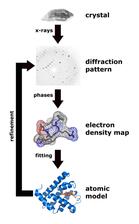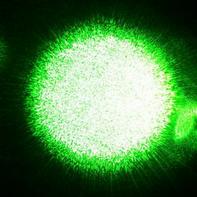The steps involved in x-ray crystallography
Hard X-ray diffraction
Most analysis of the atomic structure of solids is done using x-ray and neutron diffraction and almost all insight in this field has been gained this way.
Since the hard x-rays’ wavelength is comparable to the distance between atoms in a solid, upon illuminating a crystalline material the x-rays scatter off of the atoms, creating an interference pattern. This is what is meant when saying the x-rays are "diffracted" by the material. From this an electron density map and thus the atomic structure can be deduced and refined. Simple crystals with small repeating units can yield the positions of atoms as distinct "blobs" of electron density, while in larger molecules (as studied in protein crystallography) the atoms' positions are less well defined and displayed as connecting "tubes" of electron density. Either monochromatic light is used (“Bragg” diffraction) or white light (i.e. a broad x-ray spectrum) (“Laue” diffraction). The latter provides a lot of information in a short time span, making it ideal for the rapid study of dynamic events, since it requires only a single exposure, while Bragg diffraction requires rotation of the crystal. On the other hand, Laue diffraction is only really useful for the study of simple atomic arrangements like minerals.
This finds application in e.g.:
- Structural design of crystalline materials
- Drug design
- Biomineralization
- Residual stress determination in situ
Samples can be single crystals, in which case they need to be rotated in the diffractometer in order to capture diffracted radiation emitted in every direction and generate the complete spectrum. One can also use a powder, i.e. a collection of randomly oriented tiny crystals, in which case every incident angle of radiation will be represented by at least one of the crystals and the spectrum can be recorded in one go.
Includes: XRD; powder, single-crystal, surface diffraction; XSW
Macromolecular crystallography
Also called protein crystallography (PX), this is the best method for determining the 3D structure of biological macromolecules (mainly proteins). The technique is more or less a specialized version of hard x-ray diffraction: X-rays are passed through a crystallized sample of the molecule and the diffraction pattern analyzed. Multiwavelength anomalous diffraction (MAD) studies changes in the diffraction pattern at varying wavelengths due to the presence of heavy atoms, which allows a more advanced analysis of the structure. Typical research areas are:
- Drug design
- Enzyme mechanics
- Molecular recognition
- Structural genomics
It is extremely hard to get anything but tiny, imperfect crystals from macromolecules. Therefore the necessary precision of measurement is only possible using synchrotron light source. The tunability is also a requisite for the MAD technique.
Hard X-ray scattering
This is essentially an extension of the hard x-ray techniques to systems less than perfectly ordered and static.
Monochromatic x-rays are scattered off the sample’s atoms and the resulting intensity measured as a function of the angle, which allows deductions about the structure. Two variations of the technique are employed:
- Elastic: Wavelength/energy of the photons remains unchanged.
- Inelastic: The photon loses energy in the scattering process by exciting an electron onto a higher energy level. The energy loss can be measured using a spectrometer.
While inelastic scattering gives information about the electronic band structure of a material, the distribution of “scatterers”, i.e. the actual 3D structure needs to be determined using elastic scattering.
Again the properties of SR enable study of dilute samples and time-resolution of processes as well as other specialized techniques. Problems addressed are:
- Liquid-liquid/vapor and molecular interfaces
- Short-range order in amorphous materials
- Photons and elementary excitation in solids
- Colloids, solution-phase proteins, polymers
Of importance are:
Small angle x-ray scattering(SAXS): The pattern is collected only in a very small angle (<1 degree). It is used to obtain information about the structure of a material in terms of average particle size and shape. Compared to similar techniques, rather large features can be resolved.
Grazing incidence SAXS (GISAXS) is a similar method, only in this case surfaces and interfaces are studied.
Wide angle XS (WAXS) is used to study amorphous materials like glasses, where structures on very small scales (nearest neighbors) are important. These small structures correspond to large scattering angles in “reciprocal space”.
Includes: SAXS; WAXS; GISAXS; IXS; RIXS; NRS; XPCS; x-ray Raman, Compton scattering
Soft X-ray scattering
Similar to soft x-ray spectroscopy, photons are elastically or inelastically scattered off shallow core-level electrons and the data analyzed using speckle diffraction patterns or spectrometers. It is used for the study of:
- Strongly correlated materials
- Magnetic materials
- Environmental science
- Catalysis
Speckle patterns are generated when strongly coherent light (like laser or synchrotron light) is reflected off a rough surface. The light and dark spots are generated when light reflected off different points on the surfaces interferes constructively or destructively. Analysis of this pattern allows insight into the surface’s structure.
The tunability and brightness of the radiation are important for the same reasons as in spectroscopy.
Includes: IXS; RIXS; speckle patterns; SAXS







